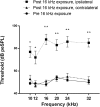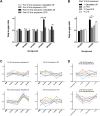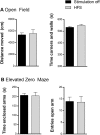Inhibition of Experimental Tinnitus With High Frequency Stimulation of the Rat Medial Geniculate Body
- PMID: 30102446
- PMCID: PMC6618158
- DOI: 10.1111/ner.12795
Inhibition of Experimental Tinnitus With High Frequency Stimulation of the Rat Medial Geniculate Body
Abstract
Background: Neuromodulation is a promising treatment modality for tinnitus, especially in chronic and severe cases. The auditory thalamus plays a key role in the pathophysiology of tinnitus, as it integrates and processes auditory and limbic information.
Objective: The effect of high frequency stimulation and low frequency stimulation of the medial geniculate bodies on tinnitus in a noise-induced tinnitus rat model is assessed.
Materials and methods: Presence of tinnitus was verified using the gap-induced prepulse inhibition of the acoustic startle response paradigm. Hearing thresholds were determined before and after noise trauma with auditory brainstem responses. Anxiety-related side-effects were evaluated in the elevated zero maze and open field.
Results: Results show tinnitus development after noise exposure and preserved hearing thresholds of the ear that was protected from noise trauma. We found that high frequency stimulation of the medial geniculate bodies suppressed tinnitus. This effect maintained directly after stimulation when the stimulator was turned off. Low frequency stimulation did not have any effects on the gap:no-gap ratio of the acoustic startle response.
Conclusion: High frequency stimulation of the MGB has a direct and residual suppressing effect on tinnitus in this animal model. Low frequency stimulation of the MGB did not inhibit tinnitus.
Keywords: Deep brain stimulation; medial geniculate body; neuromodulation; preclinical; tinnitus.
© 2018 The Authors. Neuromodulation: Technology at the Neural Interface published by Wiley Periodicals, Inc. on behalf of International Neuromodulation Society.
Figures





References
-
- Axelsson A,Ringdahl A. Tinnitus: a study of its prevalence and characteristics. Br J Audiol 1989;23:53–62. - PubMed
-
- McCormack A,Edmondson‐Jones M,Somerset S,Hall D. A systematic review of the reporting of tinnitus prevalence and severity. Hear Res 2016;337:70–79. - PubMed
-
- Lewis JE,Stephens SD,McKenna L. Tinnitus and suicide. Clin Otolaryngol Allied Sci 1994;19:50–54. - PubMed
-
- Altissimi G,Salviati M,Turchetta R et al. When alarm bells ring: emergency tinnitus. Eur Rev Med Pharmacol Sci 2016;20:2955–2973. - PubMed
-
- Maes IH,Cima RF,Vlaeyen JW,Anteunis LJ,Joore MA. Tinnitus: a cost study. Ear Hear 2013;34:508–514. - PubMed
MeSH terms
Grants and funding
LinkOut - more resources
Full Text Sources
Other Literature Sources
Medical
Miscellaneous

